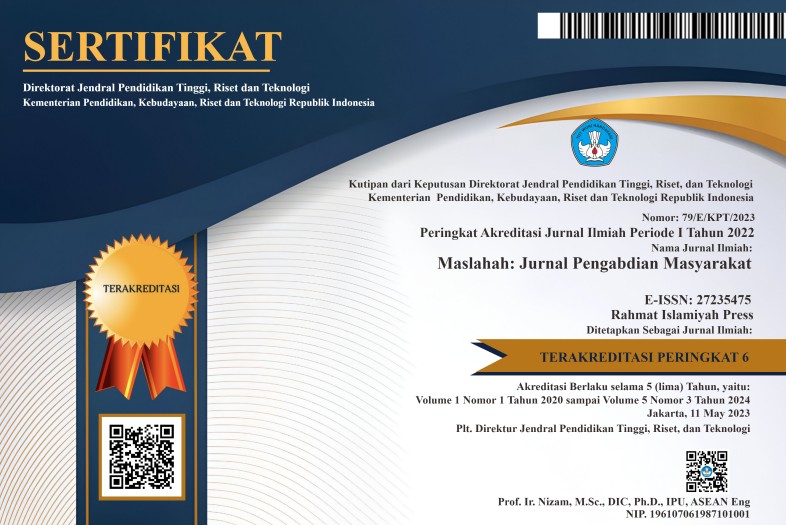Peningkatan Pendapatan Masyarakat Melalui Perkawinan Silang Ayam Hutan di Desa Teluk Pulai Dalam Kabupaten Labuhanbatu Utara
Abstract
The objective of this community service is to improve community income through the application of crossbreeding technology between male wild chickens (Gallus gallus) and local female native chickens. The main problem faced by the partner community is the low productivity of native chickens and the lack of knowledge regarding poultry breeding techniques that can enhance genetic quality and market value. The implementation methods of this activity include counseling, technical training, hands-on assistance in crossbreeding practices, and monitoring of offspring results. The results of the activity showed that the partner community was able to understand and apply crossbreeding techniques effectively. The offspring resulting from the crossbreed displayed superior physical performance, faster growth, and a higher market value. However, not many people are able to breed wild chickens due to the difficulty in obtaining pure wild chicken stock. This activity has had a positive impact on improving the skills of local farmers and has opened up the potential for increasing household income through the diversification of wild chicken breeding businesses. It is hoped that this activity can be continued independently and sustainably by the local community.
Full Text:
PDFReferences
Arifin, Z. (2019). Teknologi Tepat Guna untuk Pemberdayaan Masyarakat Pedesaan. Pustaka Pelajar.
Damayanti, L., & Nugroho, S. (2021). Peningkatan pendapatan peternak ayam kampung melalui inovasi pakan fermentasi. Jurnal Pengabdian Masyarakat Peternakan, 4(2), 45–52. https://doi.org/10.25077/jpmp.4.2.45-52.2021
Fitriani, E., & Hidayat, M. (2022). Pelatihan pemuliaan unggas untuk peternak desa. Jurnal ABDIMAS: Pengabdian Kepada Masyarakat, 6(1), 12–18. https://doi.org/10.31289/abdimas.v6i1.5243
Kementerian Keuangan Republik Indonesia. (2023). Peraturan Menteri Keuangan Republik Indonesia Nomor 49 Tahun 2023 tentang Standar Biaya Masukan Tahun Anggaran 2024.
Kementerian Pertanian Republik Indonesia. (2020). Pedoman teknis budidaya ayam kampung unggul. Direktorat Jenderal Peternakan dan Kesehatan Hewan.
Khoiridah, S., Ferriswara, D., & Devy, I. P. (2020). Merdeka berpikir: Catatan harian pandemi Covid-19. Unitomo Press.
Latifah, N. (2018). Strategi pengembangan agribisnis ayam kampung di wilayah perdesaan. Jurnal Agroekonomi, 29(1), 55–67. https://doi.org/10.21082/jae.v29n1.2018.55-67
Lembaga Penelitian dan Pengabdian kepada Masyarakat (LPPM). (2024). Panduan penelitian dan pengabdian kepada masyarakat tahun 2024. Universitas Negeri Medan.
Maulana, R., & Setiadi, R. (2021). Inovasi pemanfaatan limbah pertanian sebagai pakan alternatif ternak ayam. Jurnal Teknologi dan Agroindustri, 10(3), 98–106.
Nugroho, A., & Putri, R. D. (2020). Pengaruh persilangan ayam kampung dan ayam hutan terhadap pertumbuhan dan kualitas karkas. Jurnal Ilmu Ternak Tropika, 7(2), 134–141. https://doi.org/10.1234/jittropika.v7i2.2020
Nurhayati, Soetriono, & Akhiriani, S. (2021). Teknoekonomi pengolahan limbah kulit pisang. UNEJ Press.
Priyanto, D., & Sari, M. (2023). Pengembangan usaha penangkaran ayam lokal sebagai peluang usaha desa. Jurnal Pengabdian Masyarakat Nusantara, 5(1), 23–30.
Siregar, T. M., & Wahyuni, D. (2022). Pelatihan pengelolaan usaha ternak ayam berbasis rumah tangga. Jurnal Abdimas UMSU, 6(1), 67–74. https://doi.org/10.33059/abdimas.v6i1.2022
Syaifuddin, & Sulaiman. (2028, Desember 26). Wawancara langsung [Wawancara].
Wisswani, N. W. (2017). Prototype teknologi rantai informasi berbasis web bagi UMKM. Jurnal Manajemen Teknologi dan Informatika, 6(1).
Yulianti, R., & Saputra, H. (2021). Pemberdayaan peternak ayam melalui pelatihan teknologi reproduksi unggas. Jurnal Inovasi Pengabdian Masyarakat, 3(2), 88–95. https://doi.org/10.22225/jipm.3.2.88-95
DOI: https://doi.org/10.56114/maslahah.v6i2.12492
Refbacks
- There are currently no refbacks.
ISSN 2723-5475 (Online)



